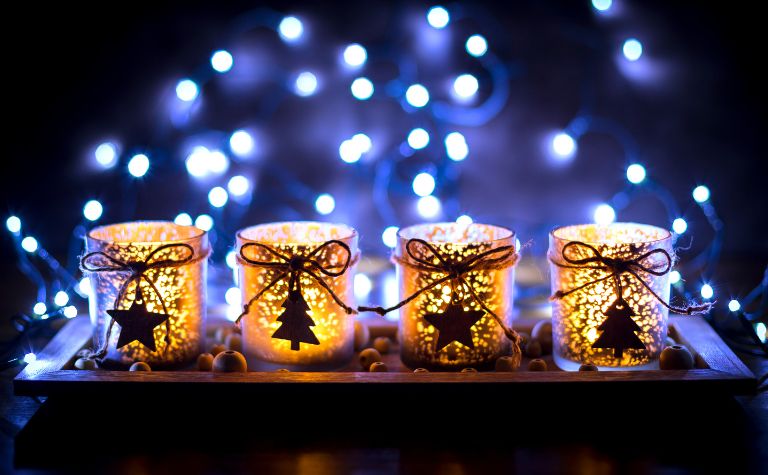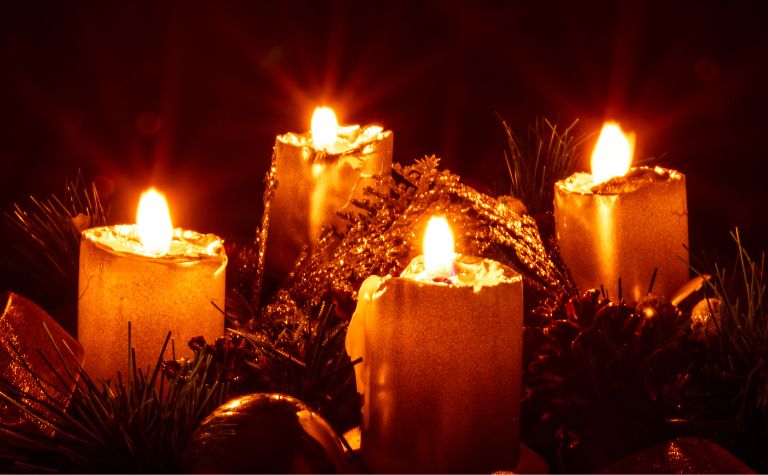As the Christmas season approaches, many Christian households around the world prepare to celebrate Advent, a time of expectant waiting and preparation for the birth of Jesus Christ.
One of the most iconic symbols of this season is the Advent wreath adorned with candles.
But what do these candles represent, and why are they such an integral part of Advent celebrations?
This article will explore the rich symbolism and meaning behind each Advent candle.
We’ll explore their historical origins, the significance of their colors, and the themes they embody.

The Meaning of the Four Candles of Advent
At the heart of the Advent wreath are the four candles lit successively on the four Sundays leading up to Christmas.
Each candle carries its own unique symbolism and is usually associated with a specific theme and color.
Understanding the meaning behind these candles can enrich your Advent experience.
Candle Colors
The colors of the candles can vary depending on the tradition, but the most common arrangement includes three purple candles and one pink candle.
Purple is the liturgical color for Advent in many Christian denominations and symbolizes penitence and preparation.
The pink candle, known as Gaudete Sunday, is lit on the third Sunday of Advent and represents joy.
First Sunday of Advent: The Hope Candle
The first candle is often purple and is commonly referred to as the “Hope” or “Prophecy” candle.
It symbolizes the hope and anticipation of the coming of the Messiah, as foretold by the prophets in the Old Testament.
Lighting this candle marks the beginning of the Advent season and sets the tone for a period of reflection and preparation.
Second Sunday of Advent: The Peace Candle
The second candle, also usually purple, is known as the “Peace” or “Bethlehem” candle.
It represents the peace that the birth of Jesus brings to the world.
The name “Bethlehem” refers to the birthplace of Jesus and serves as a reminder of the humble beginnings of the Savior.
Third Sunday of Advent: The Joy Candle
The third candle is pink and is called the “Joy” or “Shepherd’s” candle.
This candle is lit on Gaudete Sunday, a day of rejoicing and celebration in the midst of the penitential season of Advent.
The name “Shepherd’s” candle refers to the joy and wonder experienced by the shepherds upon hearing the news of Jesus’ birth.
Fourth Sunday of Advent: The Love Candle
The fourth and final candle is usually purple and is known as the “Love” or “Angel” candle.
It symbolizes the love that God showed humanity through the gift of His son, Jesus Christ.
The name “Angel” refers to the angelic announcement to the Virgin Mary that she would give birth to the Savior.
In summary, each of the four Advent candles serves as a poignant reminder of the themes that are central to the Advent season: hope, peace, joy, and love.
As each candle is lit, it progressively dispels the darkness, culminating in the celebration of the Light of the World, Jesus Christ, on Christmas Day.

The Christ Candle
While the four Advent candles are central to most Advent wreath traditions, some also include a fifth candle known as the Christ Candle.
This candle serves a special purpose and is lit on either Christmas Eve or Christmas Day, depending on the tradition.
Here’s what you need to know about the Christ Candle and its significance.
Placement and Color
The Christ Candle is usually placed in the center of the Advent wreath, distinguishing it from the four surrounding Advent candles.
It is commonly white, symbolizing purity and light.
The white color stands in contrast to the purple and pink candles, emphasizing its unique importance.
Symbolism
The Christ Candle represents Jesus Christ, often called the “Light of the World” in Christian theology.
Lighting this candle symbolizes the arrival of Christ in the world, fulfilling the prophecies and expectations signified by the four Advent candles.
It serves as a powerful reminder that the waiting of Advent has culminated in the joyous reality of Christmas.
Lighting Ceremony
The lighting of the Christ Candle is often accompanied by special readings, prayers, or hymns that focus on the birth of Jesus and the salvation he brings.
This moment is usually one of the highlights of the Christmas Eve or Christmas Day service for those who attend church, but it can also be a meaningful part of home celebrations.
Continuation into the Christmas Season
While the Advent candles are specific to the Advent season, the Christ Candle is often left burning throughout Christmas, which traditionally lasts until the Feast of the Epiphany on January 6.
This extended period of lighting serves as a reminder that the joy and light of Christ continue to be present beyond Christmas Day.
In summary, the Christ Candle adds another layer of depth and meaning to the Advent wreath.
It serves as the climax of the Advent season, transitioning us from a period of waiting and preparation to a time of celebration and joy.

The Historical Background of Advent Candles
The tradition of lighting Advent candles has deep historical roots that can be traced back to early Christian practices.
Understanding its history not only enriches the experience but also connects us to the spiritual heritage that has been passed down through generations.
Early Christian Traditions
Observing Advent as a preparation for Christmas has been a part of Christian liturgy since at least the Middle Ages.
However, the specific tradition of using a wreath and candles to mark this period is relatively recent.
It is generally believed to have originated in Germany among Lutheran communities.
The Advent Wreath
The Advent wreath itself is a circular arrangement of evergreen branches, symbolizing eternal life.
The circle has no beginning or end, much like the eternal nature of God and the everlasting life found in Christ.
The wreath typically holds four candles, each representing a specific theme associated with the Advent season.
Evolution and Widespread Adoption
Initially, the Advent wreath was primarily a home-based Christian custom. Over time, it gained popularity and found its way into church liturgies.
Today, the lighting of Advent candles is observed in various Christian denominations, including Lutheran, Anglican, and Roman Catholic churches.
Modern Interpretations
While the basic structure of the Advent wreath and the practice of lighting candles have remained relatively consistent, modern interpretations have introduced variations.
Some traditions now include a fifth candle, known as the Christ Candle, which is lit on Christmas Eve or Christmas Day to symbolize the birth of Jesus.
By understanding the historical background of the Advent candles, we gain a deeper appreciation for this cherished tradition.
From its humble beginnings in German Lutheran households to its widespread adoption across various Christian denominations, the Advent candles continue to serve as a meaningful way to prepare for and celebrate the Christmas season.
The Advent Wreath
The Advent wreath serves as the foundation for the Advent candles, and its design is rich with symbolism.
Understanding the elements that make up the Advent wreath can deepen your appreciation for this time-honored tradition.
Structure and Shape
The Advent wreath is traditionally circular, representing eternity and the unending love of God.
This shape serves as a visual reminder of the eternal life that Christians believe is offered through Jesus Christ.
Material Used
The wreath is usually made from evergreen branches, another symbol of eternal life.
Evergreens are plants that retain their leaves throughout the year, symbolizing constancy and enduring life.
Some wreaths also incorporate holly leaves, which are often interpreted as a representation of the crown of thorns worn by Jesus.
Placement of Candles
The candles are placed equidistantly around the wreath, and each one has its own significance.
Typically, there are four candles, corresponding to the four Sundays of Advent.
Some traditions include a fifth candle, known as the Christ Candle, placed in the center of the wreath and lit on Christmas Eve or Christmas Day.
Additional Decorations
While the basic elements of the Advent wreath are the evergreen branches and candles, additional decorations are often added.
These can include ribbons, pinecones, and ornaments, usually in colors that match the liturgical season, such as purple and pink for Advent.
However, these additional elements are optional and vary from one tradition to another.
How to Incorporate Advent Candles into Your Celebrations
Incorporating Advent candles into your Christmas celebrations can add a layer of depth and meaning to the season.
Whether you’re observing Advent for the first time or looking to enrich an existing tradition, here are some practical tips to make the most of this meaningful practice.
Choose the Right Wreath and Candles
- Select a Wreath: You can either purchase a pre-made Advent wreath or make your own. If you opt for DIY, consider using evergreen branches, which symbolize eternal life.
- Pick Your Candles: Choose four candles that fit securely in the wreath. The most common colors are three purple and one pink, but some traditions use blue or red candles.
Decide on a Time and Place
- Location: Decide where you’ll place the Advent wreath. It could be on a dining table, a mantelpiece, or a dedicated space.
- Timing: Choose a consistent time each day or week to light the candles. Many families do this during dinner or as part of a nightly routine.
Plan the Lighting Ceremony
- Readings and Prayers: Prepare short readings or prayers to accompany the lighting of each candle. These can be traditional Advent prayers, relevant Bible verses, or even personal reflections.
- Songs: Some families include singing a hymn or Christmas carol as part of the ceremony.
Make It a Family Affair
- Involvement: Get everyone involved by taking turns to light the candles and read the prayers or reflections.
- Discussion: Use this time to discuss the theme of each candle and what it means to each family member.
Add Personal Touches
- Custom Themes: Feel free to add your own themes or symbols that resonate with your family.
- Activity Cards: Consider including activity cards with suggestions for good deeds or family activities that align with the theme of each candle.
Safety Precautions
- Always supervise children around lit candles.
- Make sure the wreath is placed on a stable surface away from flammable objects.
- Extinguish the candles when you’re done with the ceremony.
Incorporating Advent candles into your Christmas celebrations can be a spiritually enriching experience that brings family members closer together.
It offers a moment of pause in the busy Christmas season, allowing everyone to focus on the deeper meanings of hope, peace, joy, and love.
Related Questions
Joseph, the husband of Mary and the earthly father of Jesus Christ, is depicted in the Gospels as humble, law-abiding, and obedient. In many Christmas scenes, such as in displays of the manger, he is...
The virgin Mary, the mother of Jesus, is one of the most fascinating people in the Bible. For 2,000 years, people of different eras and cultures have marveled at her faith in God. Mary's story in the...
